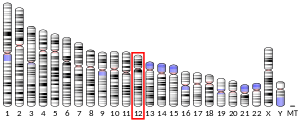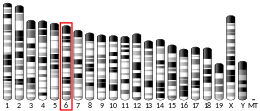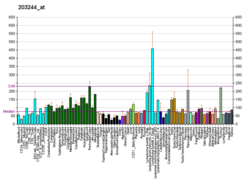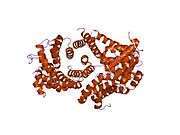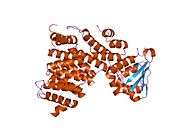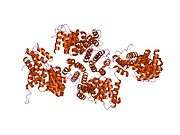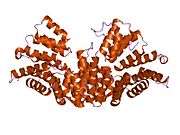PEX5
Peroxisomal targeting signal 1 receptor (PTS1R) is a protein that in humans is encoded by the PEX5 gene.[5]
PTS1R is a peroxisomal targeting sequence involved in the specific transport of molecules for oxidation inside the peroxisome. SKL binds to PTS1R in the cytosol followed by binding to the Pex14p receptor allowing importation of the peroxisomal protein through the pexsubunit transporter.
Diseases associated with dysfunctional PTS1R receptors include X-linked adrenoleukodystrophy and Zellweger syndrome.
Interactions
PEX5 has been shown to interact with PEX12,[6][7] PEX13[8][9] and PEX14.[7][9][10]
gollark: I may just format this backup disk utterly and full-disk-encrypt it instead.
gollark: I'm not actually retrieving backups from it right now, so it's "fine".
gollark: This is... worrying, my backup disk's (fscrypt) encrypted bit somehow has correct file contents but mangled filenames.
gollark: Those don't support things like compressing using a shared dictionary, and also have inconsistent support for advanced features.
gollark: There are still cases where it might be useful to read part of an archive. Such as if you have tar-based backups, or you want to read just the metadata out of a package tarball, or you want to just list all the files in a big one.
References
- ENSG00000288217 GRCh38: Ensembl release 89: ENSG00000139197, ENSG00000288217 - Ensembl, May 2017
- GRCm38: Ensembl release 89: ENSMUSG00000005069 - Ensembl, May 2017
- "Human PubMed Reference:". National Center for Biotechnology Information, U.S. National Library of Medicine.
- "Mouse PubMed Reference:". National Center for Biotechnology Information, U.S. National Library of Medicine.
- "Entrez Gene: PEX5 Peroxisomal biogenesis factor 5".
- Chang CC, Warren DS, Sacksteder KA, Gould SJ (Nov 1999). "PEX12 interacts with PEX5 and PEX10 and acts downstream of receptor docking in peroxisomal matrix protein import". The Journal of Cell Biology. 147 (4): 761–74. doi:10.1083/jcb.147.4.761. PMC 2156163. PMID 10562279.
- Okumoto K, Abe I, Fujiki Y (Aug 2000). "Molecular anatomy of the peroxin Pex12p: ring finger domain is essential for Pex12p function and interacts with the peroxisome-targeting signal type 1-receptor Pex5p and a ring peroxin, Pex10p". The Journal of Biological Chemistry. 275 (33): 25700–10. doi:10.1074/jbc.M003303200. PMID 10837480.
- Gould SJ, Kalish JE, Morrell JC, Bjorkman J, Urquhart AJ, Crane DI (Oct 1996). "Pex13p is an SH3 protein of the peroxisome membrane and a docking factor for the predominantly cytoplasmic PTs1 receptor". The Journal of Cell Biology. 135 (1): 85–95. doi:10.1083/jcb.135.1.85. PMC 2121023. PMID 8858165.
- Otera H, Setoguchi K, Hamasaki M, Kumashiro T, Shimizu N, Fujiki Y (Mar 2002). "Peroxisomal targeting signal receptor Pex5p interacts with cargoes and import machinery components in a spatiotemporally differentiated manner: conserved Pex5p WXXXF/Y motifs are critical for matrix protein import". Molecular and Cellular Biology. 22 (6): 1639–55. doi:10.1128/MCB.22.6.1639-1655.2002. PMC 135613. PMID 11865044.
- Shimizu N, Itoh R, Hirono Y, Otera H, Ghaedi K, Tateishi K, Tamura S, Okumoto K, Harano T, Mukai S, Fujiki Y (Apr 1999). "The peroxin Pex14p. cDNA cloning by functional complementation on a Chinese hamster ovary cell mutant, characterization, and functional analysis". The Journal of Biological Chemistry. 274 (18): 12593–604. doi:10.1074/jbc.274.18.12593. PMID 10212238.
Further reading
- Fransen M, Brees C, Baumgart E, Vanhooren JC, Baes M, Mannaerts GP, Van Veldhoven PP (Mar 1995). "Identification and characterization of the putative human peroxisomal C-terminal targeting signal import receptor". The Journal of Biological Chemistry. 270 (13): 7731–6. doi:10.1074/jbc.270.13.7731. PMID 7706321.
- Dodt G, Braverman N, Wong C, Moser A, Moser HW, Watkins P, Valle D, Gould SJ (Feb 1995). "Mutations in the PTS1 receptor gene, PXR1, define complementation group 2 of the peroxisome biogenesis disorders". Nature Genetics. 9 (2): 115–25. doi:10.1038/ng0295-115. PMID 7719337.
- Wiemer EA, Nuttley WM, Bertolaet BL, Li X, Francke U, Wheelock MJ, Anné UK, Johnson KR, Subramani S (Jul 1995). "Human peroxisomal targeting signal-1 receptor restores peroxisomal protein import in cells from patients with fatal peroxisomal disorders". The Journal of Cell Biology. 130 (1): 51–65. doi:10.1083/jcb.130.1.51. PMC 2120514. PMID 7790377.
- Maruyama K, Sugano S (Jan 1994). "Oligo-capping: a simple method to replace the cap structure of eukaryotic mRNAs with oligoribonucleotides". Gene. 138 (1–2): 171–4. doi:10.1016/0378-1119(94)90802-8. PMID 8125298.
- Marynen P, Fransen M, Raeymaekers P, Mannaerts GP, Van Veldhoven PP (Nov 1995). "The gene for the peroxisomal targeting signal import receptor (PXR1) is located on human chromosome 12p13, flanked by TPI1 and D12S1089". Genomics. 30 (2): 366–8. doi:10.1006/geno.1995.0032. PMID 8586442.
- Gould SJ, Kalish JE, Morrell JC, Bjorkman J, Urquhart AJ, Crane DI (Oct 1996). "Pex13p is an SH3 protein of the peroxisome membrane and a docking factor for the predominantly cytoplasmic PTs1 receptor". The Journal of Cell Biology. 135 (1): 85–95. doi:10.1083/jcb.135.1.85. PMC 2121023. PMID 8858165.
- Dodt G, Gould SJ (Dec 1996). "Multiple PEX genes are required for proper subcellular distribution and stability of Pex5p, the PTS1 receptor: evidence that PTS1 protein import is mediated by a cycling receptor". The Journal of Cell Biology. 135 (6 Pt 2): 1763–74. doi:10.1083/jcb.135.6.1763. PMC 2133940. PMID 8991089.
- Suzuki Y, Yoshitomo-Nakagawa K, Maruyama K, Suyama A, Sugano S (Oct 1997). "Construction and characterization of a full length-enriched and a 5'-end-enriched cDNA library". Gene. 200 (1–2): 149–56. doi:10.1016/S0378-1119(97)00411-3. PMID 9373149.
- Reuber BE, Germain-Lee E, Collins CS, Morrell JC, Ameritunga R, Moser HW, Valle D, Gould SJ (Dec 1997). "Mutations in PEX1 are the most common cause of peroxisome biogenesis disorders". Nature Genetics. 17 (4): 445–8. doi:10.1038/ng1297-445. PMID 9398847.
- Otera H, Okumoto K, Tateishi K, Ikoma Y, Matsuda E, Nishimura M, Tsukamoto T, Osumi T, Ohashi K, Higuchi O, Fujiki Y (Jan 1998). "Peroxisome targeting signal type 1 (PTS1) receptor is involved in import of both PTS1 and PTS2: studies with PEX5-defective CHO cell mutants". Molecular and Cellular Biology. 18 (1): 388–99. doi:10.1128/mcb.18.1.388. PMC 121509. PMID 9418886.
- Fransen M, Terlecky SR, Subramani S (Jul 1998). "Identification of a human PTS1 receptor docking protein directly required for peroxisomal protein import". Proceedings of the National Academy of Sciences of the United States of America. 95 (14): 8087–92. doi:10.1073/pnas.95.14.8087. PMC 20933. PMID 9653144.
- Amery L, Brees C, Baes M, Setoyama C, Miura R, Mannaerts GP, Van Veldhoven PP (Dec 1998). "C-terminal tripeptide Ser-Asn-Leu (SNL) of human D-aspartate oxidase is a functional peroxisome-targeting signal". The Biochemical Journal. 336 (Pt 2): 367–71. doi:10.1042/bj3360367. PMC 1219880. PMID 9820813.
- Shimizu N, Itoh R, Hirono Y, Otera H, Ghaedi K, Tateishi K, Tamura S, Okumoto K, Harano T, Mukai S, Fujiki Y (Apr 1999). "The peroxin Pex14p. cDNA cloning by functional complementation on a Chinese hamster ovary cell mutant, characterization, and functional analysis". The Journal of Biological Chemistry. 274 (18): 12593–604. doi:10.1074/jbc.274.18.12593. PMID 10212238.
- Shimozawa N, Zhang Z, Suzuki Y, Imamura A, Tsukamoto T, Osumi T, Fujiki Y, Orii T, Barth PG, Wanders RJ, Kondo N (Aug 1999). "Functional heterogeneity of C-terminal peroxisome targeting signal 1 in PEX5-defective patients". Biochemical and Biophysical Research Communications. 262 (2): 504–8. doi:10.1006/bbrc.1999.1232. PMID 10462504.
- Chang CC, Warren DS, Sacksteder KA, Gould SJ (Nov 1999). "PEX12 interacts with PEX5 and PEX10 and acts downstream of receptor docking in peroxisomal matrix protein import". The Journal of Cell Biology. 147 (4): 761–74. doi:10.1083/jcb.147.4.761. PMC 2156163. PMID 10562279.
- Watters D, Kedar P, Spring K, Bjorkman J, Chen P, Gatei M, Birrell G, Garrone B, Srinivasa P, Crane DI, Lavin MF (Nov 1999). "Localization of a portion of extranuclear ATM to peroxisomes" (PDF). The Journal of Biological Chemistry. 274 (48): 34277–82. doi:10.1074/jbc.274.48.34277. PMID 10567403.
- Okumoto K, Abe I, Fujiki Y (Aug 2000). "Molecular anatomy of the peroxin Pex12p: ring finger domain is essential for Pex12p function and interacts with the peroxisome-targeting signal type 1-receptor Pex5p and a ring peroxin, Pex10p". The Journal of Biological Chemistry. 275 (33): 25700–10. doi:10.1074/jbc.M003303200. PMID 10837480.
- Gatto GJ, Geisbrecht BV, Gould SJ, Berg JM (Dec 2000). "Peroxisomal targeting signal-1 recognition by the TPR domains of human PEX5". Nature Structural Biology. 7 (12): 1091–5. doi:10.1038/81930. PMID 11101887.
- Harano T, Nose S, Uezu R, Shimizu N, Fujiki Y (Jul 2001). "Hsp70 regulates the interaction between the peroxisome targeting signal type 1 (PTS1)-receptor Pex5p and PTS1". The Biochemical Journal. 357 (Pt 1): 157–65. doi:10.1042/0264-6021:3570157. PMC 1221938. PMID 11415446.
- Saidowsky J, Dodt G, Kirchberg K, Wegner A, Nastainczyk W, Kunau WH, Schliebs W (Sep 2001). "The di-aromatic pentapeptide repeats of the human peroxisome import receptor PEX5 are separate high affinity binding sites for the peroxisomal membrane protein PEX14". The Journal of Biological Chemistry. 276 (37): 34524–9. doi:10.1074/jbc.M104647200. PMID 11438541.
- Stanley WA, Filipp FV, Kursula P, Schüller N, Erdmann R, Schliebs W, Sattler M, Wilmanns M (Dec 2006). "Recognition of a functional peroxisome type 1 target by the dynamic import receptor pex5p". Molecular Cell. 24 (5): 653–63. doi:10.1016/j.molcel.2006.10.024. PMC 5030714. PMID 17157249.
External links
This article is issued from Wikipedia. The text is licensed under Creative Commons - Attribution - Sharealike. Additional terms may apply for the media files.

